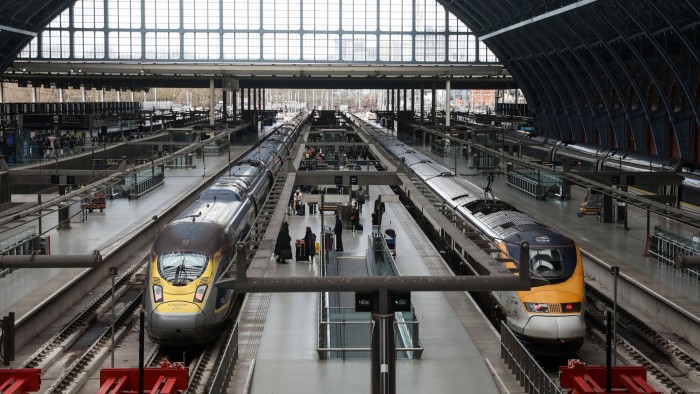Unlock the Editor’s Digest for free
Roula Khalaf, Editor of the FT, selects her favourite stories in this weekly newsletter.
The owner of the high-speed rail line from London to the Channel Tunnel has offered a price cut to encourage the launch of more international rail services to and from its London St Pancras terminus.
London St Pancras Highspeed (LSPH) unveiled several financial incentives on Friday available to any operator that launches rail services between London and mainland Europe.
Several groups in recent months have announced plans to launch services between London and the continent. Eurostar, the only existing operator, has had a monopoly on the services, which mostly link London to Paris and Brussels, since international passenger services started in 1994.
LSPH, formerly known as HS1, said the discounts would be available either to new entrants or to Eurostar if it launched new services.
Robert Sinclair, LSPH chief executive, said: “Never before in the history of high-speed rail in the UK have we seen this much interest in growth, and the potential for competition.”
Sir Richard Branson’s Virgin Group is among several operators contemplating the launch of services linking the UK and mainland Europe. Eurostar also has significant growth plans.
However, the new entrants face challenges, particularly the high costs of ordering trains and running on the high-speed tracks in the UK. LSPH charges about £7,600 per train journey in fees.
Sinclair said it was “fair to say” there were “significant barriers to entry” in the cross-Channel market.
“It’s not a cheap thing to do,” he said. “The growth incentive scheme is designed specifically to help operators reduce some of those costs and . . . get across those barriers to entry.”
Operators will be able to take advantage of the discounts any time until 2035. In the first of three discounted years, they will offer a maximum discount of 50 per cent on the “investment recovery charge” element of the operator’s charges. The discount will fall to 40 per cent in the second year and 30 per cent in the third.
The investment recovery charge accounts for about £4,000 of the total charges for each journey.
LSPH said the price cuts could save each train operator between £40mn and £60mn over the three years, depending on the nature of the services.
Operators could access the discounts by launching services or destinations or by investing in new trains. If Eurostar added one extra train daily between London and Paris, that service would qualify for discounted access. Equally, a new operator could also be given discounts on each of its routes, as they would all be classified as new.
“Our hope is that these interventions are going to drive growth, result in competition, and we could see 50 per cent or more increase in train services in the next few years,” Sinclair said.
Earlier this week, the potential Eurostar competitors were boosted after the UK’s rail regulator said there was space for rivals to access the company’s east London train depot.
Eurostar said it welcomed LSPH’s proposals, which are subject to a consultation that begins on Friday. The scheme is then set to come into operation on May 30.
“Eurostar welcomes any incentives which enable more sustainable international travel and support our plans to run more services,” it said.
Virgin Group also welcomed the plans. “London St Pancras Highspeed is working hard to unlock competition on the cross-Channel route and the new international growth incentive scheme is a welcome step in the right direction,” the company said.





1 Comment
krs40z